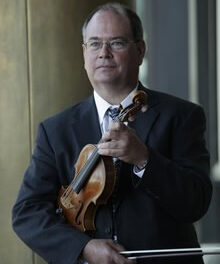There is nothing finer than hearing a concert in the intimate, warm acoustics of the Home Moravian Church in the picturesque environs of Old Salem. These popular, free concerts are part of the “Music at Home” series hosted at the church. The weekend’s snow storm and the subsequent closure of the popular tourist site slowed the formation of lines to get into the church. I was even able to park within sight of it! By concert time, the balcony and most of downstairs was packed with music lovers and musicians’ relatives.
The 46 members of the University of North Carolina School of the Arts‘ Cantata Singers were arranged in front of the church’s choir stall. This accomplished choir is composed of voice majors from both the undergraduate and high school divisions of the School of Music along with a few from other disciplines. They rehearse four days a week and present three concerts per academic year, besides serving as the opera chorus for the Fletcher Opera Institute’s main stage productions.
Below was seated a 14 member chamber orchestra made up of some of the finest players in the area including members of the Greensboro and Winston-Salem symphonies. The concertmaster was Fabrice Dharamraj. Organ and percussion accompaniment was by Susan Keck Foster, the organist at Home Moravian Church. UNCSA faculty member Dr. Nathan Zullinger was the very effective conductor.
In contrast to the better known, brilliant, and festive Magnificat S. 243 of Johann Sebastian Bach (1685-1750), the Magnificat RV 611 of Antonio Vivaldi (1678-1741) is introspective and deeply meditative. Both are settings of a poem of rejoicing from the Gospel of Luke, attributed to the Virgin Mary. It is used liturgically during Vespers or Evening Prayer. Vivaldi’s original was composed in 1717, and the composer reworked it several times before coming up with the final version that was performed at this concert. Elaborate solo movements bear the names of the original women singers of the Ospedale della Pietà.
Zullinger led his forces in a remarkably clear and effective performance of the Vivaldi. The opening chorus’ diction was exceptional and they were ably supported by the full orchestra. The four solo arias, IIa-IIc, VI, and VIII, were supported by fine principal strings of Dharamraj, second violinist Gregorio Midero, violist Simon Ertz, and cellist J. Alexandra Johnston, with Foster’s subtle organ continuo. Soprano Peyton Marion sang “Et exsultavit” with fine tone and nicely executed ornamentation. Soprano Savanna Strange sang “Quia respexit,” and soprano Logan Trotter sang “Quia fecit,” the exceptionally festive aria, with equal artistic qualities. Mezzo-soprano Veronica Siebert brought a firmly supported voice to the aria “Esurientes.” Countertenor Taylor Mason Boone’s singing of “Sicut locutus est” was simply magnificent! The intensive vocal training of the individual singers in the choir was telling in the extraordinarily even vocal quality as well as textual clarity of their combined efforts in the choral parts.
The Quatre Motets pour le Temps de Nöel (1951) by Francis Poulenc (1899-1963) gave the Cantata Singers a chance to demonstrate a cappella excellence. Unlike Poulenc’s sarcastic, jazzy, and witty works, the motets find the composer giving voice to his own deeply held Catholic faith. The first motet, “O magnum mysterium,” announces the coming of the Baby Jesus and praises the Virgin Mary. A pure soprano melody hovers over the hushed accompaniment of the three lower voices. The text of the Christmas Matins service is used for the second theatrical motet “Quem vidistis pastores dicite.” In the angelic chorus portion, the soprano, alto, and tenor sections play off the bass section in a careful word-for-word setting culminating in a fff “Dicite.” The third motet, “Videntes stellam,” creates a light, airy texture using the upper three voices. A chromatic texture portrays the entrance of the Magi and their gifts. The composer’s famous sense of humor is shown in the “kiss” given in the final chord of the ebullient elaborate final motet, “Hodie, Christus natus est.”
Zullinger led the Cantata Singers in a remarkably effective performance. Every strand of text was delivered with crystalline clarity. The four vocal sections of the chorus were exceptionally evenly balanced.
The fine quality of the concert’s chamber orchestra was featured in the next work for orchestra alone, Fantasia on “Greensleeves” by Ralph Vaughan Williams (1872-1958). Flutists Debra Pivetta and Lissie Shanahan and harpist Beth Ann Henson filled out the ensemble with gorgeous solo roles.
In Terra Pax, Op. 39 (1954) by Gerald Finzi (1901-56) concluded the concert. The horrors of the First World War haunted the composer and influenced his selection of poems from “Nöel: Christmas Eve 1913” by Robert Bridges (1844-1930). Finzi choose the first and last poems, “A frosty Christmas eve” and “But to me heard a far,” sandwiched around the angelic announcement of Christ’s birth to the shepherds abiding in the field from the Gospel of Luke.
Zullinger directed a deeply moving interpretation. Basses Omarius Credle, Eric B. Powell, and Scott Lee were very effective in their solo roles respectively in the two outer stanzas. The fine soloist in the middle nativity section was soprano Alexandra Church. Foster played the subtle cymbal part while Henson’s harp added to the serene atmosphere.
***Edited 12/13/17











